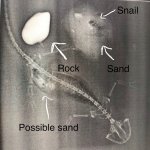Morrison
Active member
- Joined
- Jul 17, 2010
- Messages
- 1,625
- Reaction score
- 16
- Points
- 38
- Country
- Netherlands
Wow, that explains where all the mysterious sand keeps coming from when I have them in a bare tank.Sand doesn't pass straight through an axolotl, there is an actual buildup which can be seen when an axolotl is kept in a bare tank after being kept on sand. The sand will keep appearing for weeks, which is a lot slower than an axolotl digests its food, so obviously some of the sand is holding in the gut.
I always blamed the filter.

